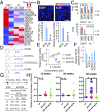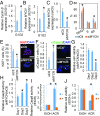Prevention of hepatocellular carcinoma by targeting MYCN-positive liver cancer stem cells with acyclic retinoid
- PMID: 29686061
- PMCID: PMC5949003
- DOI: 10.1073/pnas.1802279115
Prevention of hepatocellular carcinoma by targeting MYCN-positive liver cancer stem cells with acyclic retinoid
Abstract
Hepatocellular carcinoma (HCC) is a highly lethal cancer that has a high rate of recurrence, in part because of cancer stem cell (CSC)-dependent field cancerization. Acyclic retinoid (ACR) is a synthetic vitamin A-like compound capable of preventing the recurrence of HCC. Here, we performed a genome-wide transcriptome screen and showed that ACR selectively suppressed the expression of MYCN, a member of the MYC family of basic helix-loop-helix-zipper transcription factors, in HCC cell cultures, animal models, and liver biopsies obtained from HCC patients. MYCN expression in human HCC was correlated positively with both CSC and Wnt/β-catenin signaling markers but negatively with mature hepatocyte markers. Functional analysis showed repressed cell-cycle progression, proliferation, and colony formation, activated caspase-8, and induced cell death in HCC cells following silencing of MYCN expression. High-content single-cell imaging analysis and flow cytometric analysis identified a MYCN+ CSC subpopulation in the heterogeneous HCC cell cultures and showed that these cells were selectively killed by ACR. Particularly, EpCAM+ cells isolated using a cell-sorting system showed increased MYCN expression and sensitivity to ACR compared with EpCAM- cells. In a long-term (>10 y) follow-up study of 102 patients with HCC, MYCN was expressed at higher levels in the HCC tumor region than in nontumor regions, and there was a positive correlation between MYCN expression and recurrence of de novo HCC but not metastatic HCC after curative treatment. In summary, these results suggest that MYCN serves as a prognostic biomarker and therapeutic target of ACR for liver CSCs in de novo HCC.
Keywords: MYCN; acyclic retinoid; cancer stem cell; hepatocellular carcinoma; transcriptome.
Copyright © 2018 the Author(s). Published by PNAS.
Conflict of interest statement
The authors declare no conflict of interest.
Figures




Comment in
-
Reply to Yoshida: Liver cancer stem cells: Identification and lipid metabolic reprogramming.Proc Natl Acad Sci U S A. 2018 Jul 10;115(28):E6390-E6391. doi: 10.1073/pnas.1808740115. Epub 2018 Jun 25. Proc Natl Acad Sci U S A. 2018. PMID: 29941607 Free PMC article. No abstract available.
-
How to eliminate MYCN-positive hepatic cancer stem cells to prevent the recurrence?Proc Natl Acad Sci U S A. 2018 Jul 10;115(28):E6388-E6389. doi: 10.1073/pnas.1808092115. Epub 2018 Jun 25. Proc Natl Acad Sci U S A. 2018. PMID: 29941608 Free PMC article. No abstract available.
Similar articles
-
Lipid desaturation-associated endoplasmic reticulum stress regulates MYCN gene expression in hepatocellular carcinoma cells.Cell Death Dis. 2020 Jan 27;11(1):66. doi: 10.1038/s41419-020-2257-y. Cell Death Dis. 2020. PMID: 31988297 Free PMC article.
-
WM130 preferentially inhibits hepatic cancer stem-like cells by suppressing AKT/GSK3β/β-catenin signaling pathway.Oncotarget. 2016 Nov 29;7(48):79544-79556. doi: 10.18632/oncotarget.12822. Oncotarget. 2016. PMID: 27783993 Free PMC article.
-
Serum MYCN as a predictive biomarker of prognosis and therapeutic response in the prevention of hepatocellular carcinoma recurrence.Int J Cancer. 2024 Aug 1;155(3):582-594. doi: 10.1002/ijc.34893. Epub 2024 Feb 21. Int J Cancer. 2024. PMID: 38380807
-
Pharmaceutical and nutraceutical approaches for preventing liver carcinogenesis: chemoprevention of hepatocellular carcinoma using acyclic retinoid and branched-chain amino acids.Mol Nutr Food Res. 2014 Jan;58(1):124-35. doi: 10.1002/mnfr.201300538. Epub 2013 Nov 24. Mol Nutr Food Res. 2014. PMID: 24273224 Review.
-
Cancer stem cell as a potential therapeutic target in hepatocellular carcinoma.Curr Cancer Drug Targets. 2012 Nov 1;12(9):1081-94. doi: 10.2174/156800912803987995. Curr Cancer Drug Targets. 2012. PMID: 22873219 Review.
Cited by
-
Development and validation of epithelial mesenchymal transition-related prognostic model for hepatocellular carcinoma.Aging (Albany NY). 2021 Apr 30;13(10):13822-13845. doi: 10.18632/aging.202976. Epub 2021 Apr 30. Aging (Albany NY). 2021. PMID: 33929972 Free PMC article.
-
Integrated analysis revealing a novel stemness-metabolism-related gene signature for predicting prognosis and immunotherapy response in hepatocellular carcinoma.Front Immunol. 2023 Aug 9;14:1100100. doi: 10.3389/fimmu.2023.1100100. eCollection 2023. Front Immunol. 2023. PMID: 37622118 Free PMC article.
-
A high-throughput screening platform to identify MYCN expression inhibitors for liver cancer therapy.Front Oncol. 2025 Feb 14;15:1486671. doi: 10.3389/fonc.2025.1486671. eCollection 2025. Front Oncol. 2025. PMID: 40027135 Free PMC article.
-
Inhibition of Ganglioside Synthesis Suppressed Liver Cancer Cell Proliferation through Targeting Kinetochore Metaphase Signaling.Metabolites. 2021 Mar 15;11(3):167. doi: 10.3390/metabo11030167. Metabolites. 2021. PMID: 33803928 Free PMC article.
-
MicroRNA-493-5p-mediated repression of the MYCN oncogene inhibits hepatic cancer cell growth and invasion.Cancer Sci. 2020 Mar;111(3):869-880. doi: 10.1111/cas.14292. Epub 2020 Jan 25. Cancer Sci. 2020. PMID: 31883160 Free PMC article.
References
-
- Venook AP, Papandreou C, Furuse J, de Guevara LL. The incidence and epidemiology of hepatocellular carcinoma: A global and regional perspective. Oncologist. 2010;15:5–13. - PubMed
-
- Perz JF, Armstrong GL, Farrington LA, Hutin YJ, Bell BP. The contributions of hepatitis B virus and hepatitis C virus infections to cirrhosis and primary liver cancer worldwide. J Hepatol. 2006;45:529–538. - PubMed
-
- Yoshimoto S, et al. Obesity-induced gut microbial metabolite promotes liver cancer through senescence secretome. Nature. 2013;499:97–101, and erratum (2014) 506:396. - PubMed
-
- Kang TW, et al. Senescence surveillance of pre-malignant hepatocytes limits liver cancer development. Nature. 2011;479:547–551. - PubMed
Publication types
MeSH terms
Substances
LinkOut - more resources
Full Text Sources
Other Literature Sources
Medical
Molecular Biology Databases
Miscellaneous

